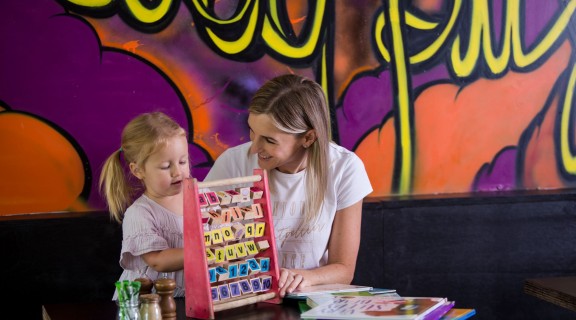
Big or small, opposites are fun!
4 April 2022 | State Library of Queensland
A good vocabulary is essential for communicating. Understanding the concept of opposites helps a child learn to compare two different things and to develop a more concrete understanding of specific concepts, such as big vs little.
Learning opposites also helps children describe things and to develop mathematical, observational, creative thinking, and language skills as they identify opposite characteristics of different objects.
Activity
- Share a book of opposites and talk about opposites, pointing to the pictures as you go. Ask children if they can think of opposite for some of the words in the book. Talk about the attributes of things that define them as opposite. Use props and other aids to increase learning.
- Provide old magazines, newspapers, and catalogues for your toddler to make a collage with many ‘opposite’ images such as happy and sad faces, night-time and daytime images. Paste the sad faces on one side of your collage, and happy faces on the other.
- Provide a container with a range of materials and encourage children to choose opposite items. Encourage them to look at size, colour, and texture such as rough and smooth. If your container includes photographs, ask children to find pictures that depict opposite emotions or activities.
- Using a ball and bucket, cup or box, teach your toddler in and out, over and under, as well as up and down, and near and far.
The opposites game
This is game does not require toys or props! Once familiar with the game, ask your child to do the opposite. For example, if you reach up, your toddler will reach down. Here are a few opposites to try:
- Reach high to the sky and low to the ground
- Take a big step and a little step
- Clap your hands loudly and quietly
- Run fast, then slow (toddler’s pace)
- Happy face, sad face
- Fill a cup with water, empty cup
- Open lid, shut lid
- Sit down, stand up
- Turn to the right and then left
Talk with your child about opposites as you go about your day. Ask questions and engage children in discussions that encourage them to notice differences. For example, "That dog is big. Can you see something that is small?", or "The grass in the park is so soft, but the road is hard". Once you get started you will find that there is no end to the opportunities available for including opposites in your discussions.
By introducing the concept of opposites to the children in your life you’re helping grow their vocabulary, build comprehension skills, intelligence and introduce them to descriptive words. Who’d have thought you could do all this with simple opposites? Whatever ideas or lesson you’re sharing, make sure it’s fun and enjoyable!
Books about opposites
- Big and Little by Harriet Evans
- The Perfect Seat by Minh Lê
- Opposites by Britta Teckentrup
- Double Take! by Susan Hood
- Dinosaur Roar! by Paul Stickland
- A Little Book About Opposites by Leo Lionni
Ask your local Queensland public library or Indigenous Knowledge staff about books on opposites. They may have some of these titles or suggest other books on opposites.
Comments
Your email address will not be published.
We welcome relevant, respectful comments.